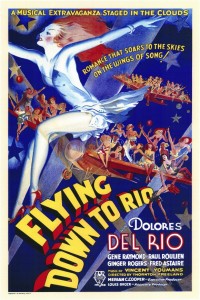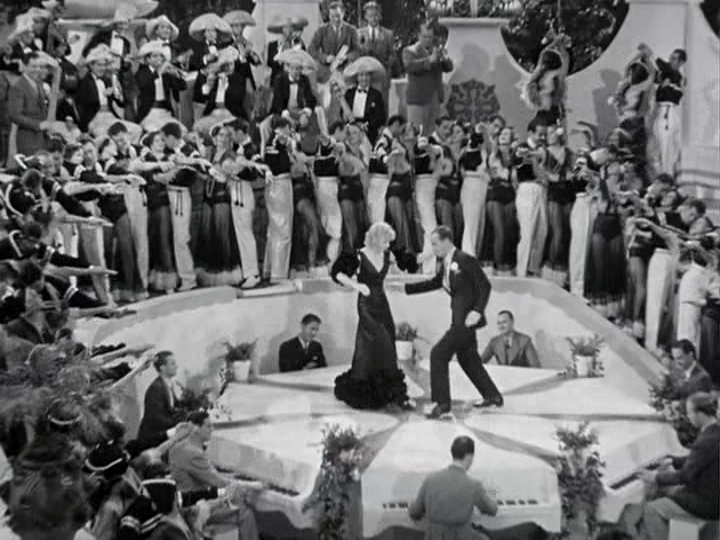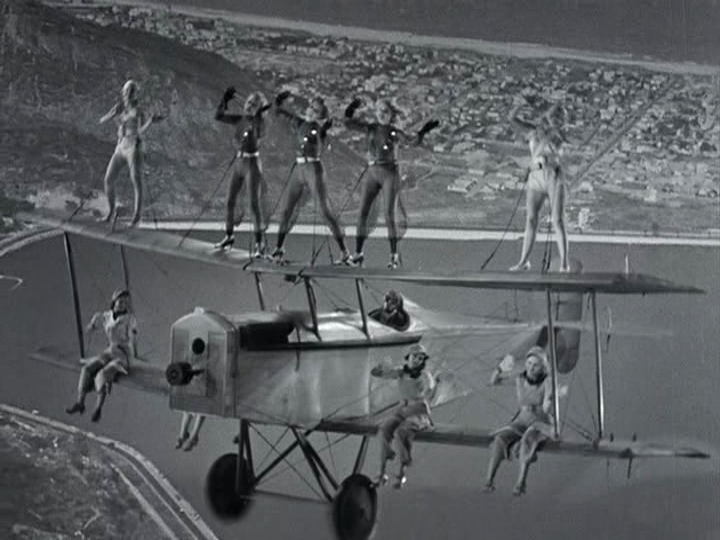|

Synopsis:
Flirtatious bandleader Roger Bond (Gene Raymond) falls in love with a beautiful Brazilian socialite named Belinha (Dolores Del Rio), unaware that she’s already engaged to his friend Julio (Raul Roulien). Meanwhile, when Bond brings his band — including dancers Fred (Fred Astaire) and Honey (Ginger Rogers) — to Rio for a gig at Belinha’s father’s hotel, he discovers that members of a powerful bank eager to take over the hotel are determined to stop the show from taking place.
|
|
Genres, Themes, Actors, and Directors:
- Dolores Del Rio Films
- Fred Astaire Films
- Ginger Rogers Films
- Love Triangle
- Musicals
- Romantic Comedy
Response to Peary’s Review:
Peary argues that despite being fourth- and fifth-billed in their first onscreen pairing (behind top-billed romantic leads Dolores Del Rio and Gene Raymond), Rogers and Astaire “steal [this] film” as they “do their one duet” together, dancing “The Carioca” and “giving off electricity that Raymond and… Del Rio are unable to equal”. He notes that “despite some dull spots and a flimsy plot”, the picture remains “romantic, sexy, and delightfully and inventively kitschy”, with “some tricky camera work, unusual art design by Van Nest Polglase and Carroll Clark, and some creative production numbers” — most notably the “unforgettable” aerial ballet finale featuring “scantily clad chorus girls strik[ing] provocative pre-Hollywood poses on the wings of airplanes in flight”.
Indeed, while “Rogers and Astaire are the main reason this film” has remained in film lovers’ consciousness (most know of it simply as the movie that sparked Astaire and Rogers’ lengthy onscreen partnership), it’s ultimately more “bizarre” than “innocuous”, and offers some unexpected pleasures here and there — such as the use of shadowy silhouettes (accompanied by an unforgettably wonky musical theme) to represent the three “evil” bank members, or the surreal outcome of Del Rio and Raymond’s overnight island stay. Meanwhile, the culminating aerial sequence (complete with one chorine nearly falling to her death!) is certainly worth a look for curiosity-value alone — though it’s not quite enough to raise the film as a whole to the level of “must see” viewing.
Redeeming Qualities and Moments:
- Astaire and Rogers dancing the Carioca

- Astaire finding himself unable NOT to dance when he hears band music starting up

- The justifiably infamous “aerial ballet” scene

- Some fun pre-code zingers (see quote at beginning of review)
Must See?
No, though of course anyone interested in the evolution of the Astaire-Rogers films will want to check it out.
Links:
|
One thought on “Flying Down to Rio (1933)”
A once-must, as a good example of deft, detailed handling of early musical comedy (in this case by little-known director Thornton Freeland), and for its creative visual sense and snappy numbers.
First viewing.
~ and I was very pleasantly surprised, indeed. This is simply charming entertainment from start to finish. Unlike ‘Roberta’ – which I’d just watched – it has a uniform period tone (especially with the music) and a rather clear through-line. The dialogue more or less crackles – and there’s an occasional hint of ‘naughtiness’, since the Hays Code was still a year away from being enforced.
In this initial pairing of theirs, Astaire and Rogers show (as they do in ‘Roberta’) that it’s often the ones playing the secondary roles who have the most fun. (They’re not as saddled with the trappings of ‘love interest’.) Raymond and Del Rio are both nice to look at – but they’re really only allowed a little ‘meat’ when they are suddenly alone on what they think is a deserted island. (Del Rio happening upon ‘cannibals’ is a very clever bit.) On the other hand, in what could easily be a throwaway part of little consequence, Roulien (unfortunately not really known for another US film) lends subtlety and dignity to his role, and is therefore touching. His rendition of ‘Orchids in the Moonlight’ – with the ever-changing, sometimes kaleidoscopic background – is a warm, wonderfully romantic highlight.
But, yes, it’s mostly the Astaire and Rogers show, as they sing and dance their way effortlessly into our hearts. As well, there’s an added plus: once the story lands in Rio (with intro shots of the place actually shifting like a batch of postcards!), a very large chorus of singers/dancers is on board for a few unforgettable numbers that may very well have inspired Busby Berkeley (in part). (Strangely, no choreographer is credited, but IMDb lists Dave Gould as dance director.) I happen to love the twelve-minute-plus ‘Carioca’ sequence.* One would think that something so repetitive would become tiresome – but it shifts constantly into a different riff. The group numbers really are a visual treat (including nifty touches like a circle of pianos pieced together like a pie and a band riding above the dancers in a hot-air balloon).
What’s saved for last is quite a finish: the film’s theme song could not be better represented for high-flying thrills.** (Personally, I could have done without the one girl suddenly falling through the air – a mere seconds but unnecessary and disturbing.)
‘Overall, ‘FDTR’ is a solid musical of the period and, as such, should be seen by ffs for its fun factor.
*’The Carioca’ song is parodied at the beginning of ‘The Kentucky Fried Movie’ during the opening credits. It’s sung (purposely off-key) by well-known singer Jo Stafford who, as a gag, used to record entire albums of her singing badly with a full orchestra. (She and her husband Paul Weston were notoriously known as Jonathan and Darlene Edwards. I still adore her ‘terrible’ version of ‘Autumn in New York’.)
**Ken Russell would pay homage to this sequence in ‘The Boy Friend’.
Note: This film is referenced significantly in the 1968 film ‘The Subject Was Roses’.